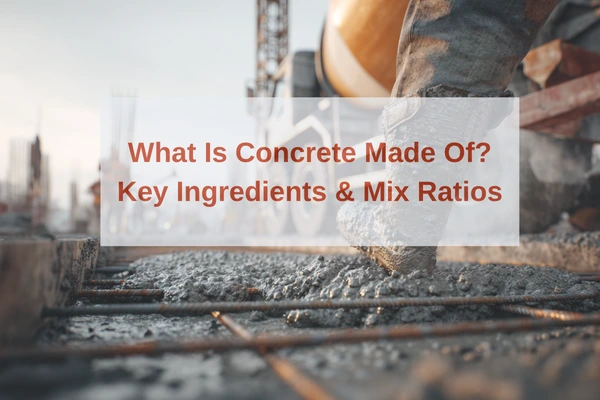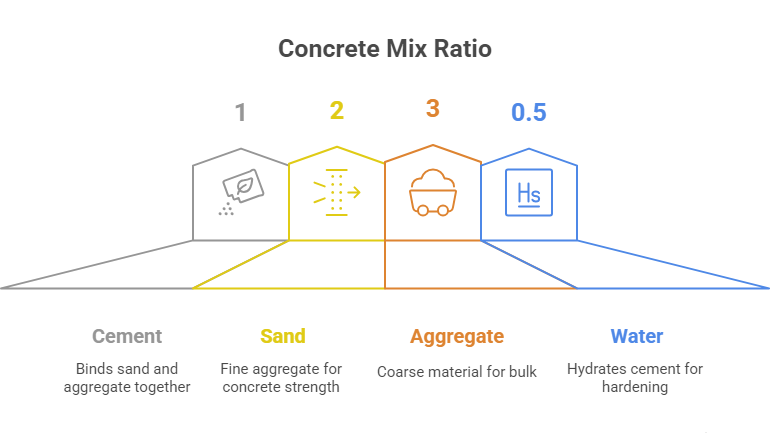
Concrete is one of the most widely used construction materials in the world. It’s strong, durable, and versatile, making it essential for everything from sidewalks and driveways to skyscrapers and bridges. But have you ever wondered what exactly goes into making concrete?
At its core, concrete is a mixture of a few key ingredients that, when combined, create a hard, rock-like material. The exact proportions can vary depending on the desired strength and application, but the basic components remain the same. Let's explore each ingredient.
콘크리트는 무엇으로 만들어지나요?
What goes into making concrete? The basic ingredients are surprisingly simple: cement, water, and aggregates. That's it! While it may sound too straightforward, the real magic lies in how these ingredients work together.
시멘트
Cement is just one ingredient in concrete - it acts as the binding agent. Made from limestone, clay, shells, and silica sand, these materials are heated and ground with gypsum to create Portland cement, the most common type used in concrete.
While cement makes up only about 10-15% of the concrete mix by volume, it’s the most chemically active ingredient. When mixed with water, it undergoes a process called 수분 공급, which causes it to harden and bind the other materials together.
[Related: The Difference Between Cement & Concrete]
물
Water is essential for the chemical reaction that turns cement into a solid binder. The right amount of water is crucial—too little and the mix will be dry and crumbly; too much and the concrete will be weak and prone to cracking.
그리고 water-to-cement ratio is a critical factor in determining the strength and durability of concrete. A typical W/C ratio is around 0.4 - 0.6, meaning for every pound of cement, you’d use about 0.4 to 0.6 pounds of water.
Aggregates (Sand, Gravel, Crushed Stone)
Aggregates make up the bulk of concrete (about 60-75% of the total volume) and provide structural strength. They usually include things like sand, gravel, or crushed stone. Without aggregates, you’d end up with a heavy, expensive block of cement that’d crack all over the place. Aggregates help with strength, stability, and even reduce the cost.
There are two types: fine aggregates (like sand) and coarse aggregates (like gravel or crushed rock). The mix and size of these aggregates can vary depending on what the concrete’s being used for.
Admixtures (Optional but Common)
While the three ingredients above are all you technically need to make concrete, most modern mixes include admixtures—chemicals or additives that improve certain properties. Some common types include:
- Plasticizers (Water reducers) – Make the mix easier to work with without adding extra water.
- 액셀러레이터 – Speed up the curing process (useful in cold weather).
- 리타더 – Slow down curing (helpful in hot weather or for large pours).
- Air-entraining agents – Create tiny air bubbles to improve freeze-thaw resistance.
- Superplasticizers – Allow for very fluid concrete (used in high-strength or self-leveling mixes).
Admixtures are especially important in specialized concrete applications, such as high-performance structures or decorative concrete.

What is the ratio for concrete batching?
When we talk about the batching ratio for concrete, we're basically talking about how much of each ingredient goes into the mix. The basic mix ratio for concrete (often used in small projects like patios, sidewalks, or slabs).
A typical mix you’ll hear about is the 1:2:3 ratio. That means:
- 1 part cement
- 2 parts sand (fine aggregate)
- 3 parts gravel or crushed stone (coarse aggregate)
Then you add water—usually about 0.5 parts, depending on the job and the climate. That water-cement ratio is super important. More water makes the concrete easier to work with, but it can also make it weaker. Less water means stronger concrete, but it's harder to pour and finish.
This 1:2:3 mix is great for general-purpose concrete like driveways, sidewalks, and slabs. But for heavier-duty jobs—like bridge supports or high-rise buildings—the mix might change. Engineers will adjust the proportions and even add in other materials to make sure the concrete meets the required strength and durability.
Batching can be done by volume (using buckets or shovels) or by weight (which is more precise and used in larger projects). Either way, consistency is key. You want each batch to be as close to the same as possible so the final structure is solid and safe.

How Is Concrete Made?
Alright, so now that we know what goes in, how do you actually make the stuff?
It’s not rocket science, but there’s definitely an art to it.
Step 1: Getting the Mix Right
First things first: you need the right proportions. That’s often referred to as the "mix design." Different jobs need different mixes. A sidewalk doesn’t need the same kind of concrete as a bridge, for example.
A common ratio for basic concrete might be 1 part cement, 2 parts sand, and 3 parts gravel, with about half a part water. But again, this can vary.
The goal is to balance strength, durability, and workability. If it’s too dry, it’s hard to pour. Too wet, and it might not be strong enough.
Step 2: Mixing Everything Together
Once you’ve got your ingredients measured out, it’s time to mix. This can be done by hand for small jobs, but bigger projects use mixers—either portable drum mixers or those big trucks you see spinning down the road.
Everything gets tossed in: aggregates first, then cement, then water. And then it’s mixed until it’s all nice and uniform. No dry patches. No overly wet spots. Just a good, even mix.
Step 3: Pouring the Concrete
After it’s all mixed up, you’ve gotta move fast. Concrete starts setting pretty quick. Once poured into the forms or molds, it’s spread out and leveled. This step is called placing and screeding.
Then it gets smoothed with a float. For bigger surfaces, power tools might be used to make it nice and flat.
Step 4: Curing the Concrete
Now here’s a part people often overlook: curing. This isn’t just letting it dry. Curing is about keeping it moist so it can properly harden. That hydration process we talked about earlier? It takes time. Usually several days, sometimes weeks.
If concrete dries out too fast, it can crack or end up weaker than it should be. So, folks might spray it with water, cover it with plastic, or use curing compounds to keep that moisture locked in.
Step 5: Finishing Touches
After curing, sometimes you’ll do a little more finishing, like sealing it to keep out water and stains or adding textures if it’s a decorative surface.
[관련: 콘크리트가 마르는 데 얼마나 걸리나요?]

결론
Concrete may seem like a simple material, but it's a highly engineered blend of ingredients that work together to provide strength, durability, and versatility. The basic components—시멘트, 물, 골재—form the core of the mix, while admixtures and supplementary materials fine-tune its properties to meet a wide range of construction needs.
Whether you're pouring a sidewalk or constructing a skyscraper, understanding the ingredients in concrete helps ensure better performance, lower costs, and a more sustainable built environment.


댓글 남기기